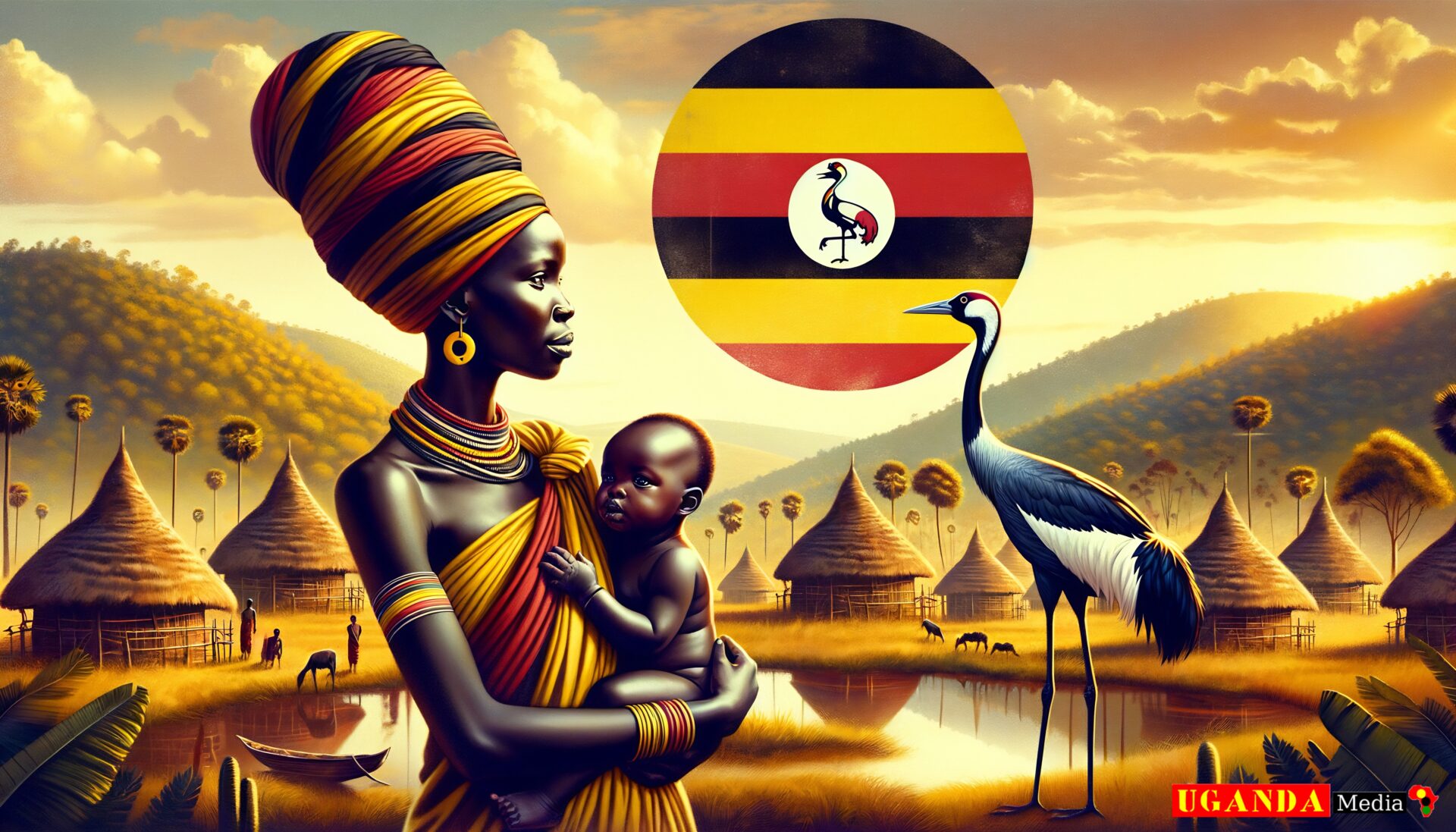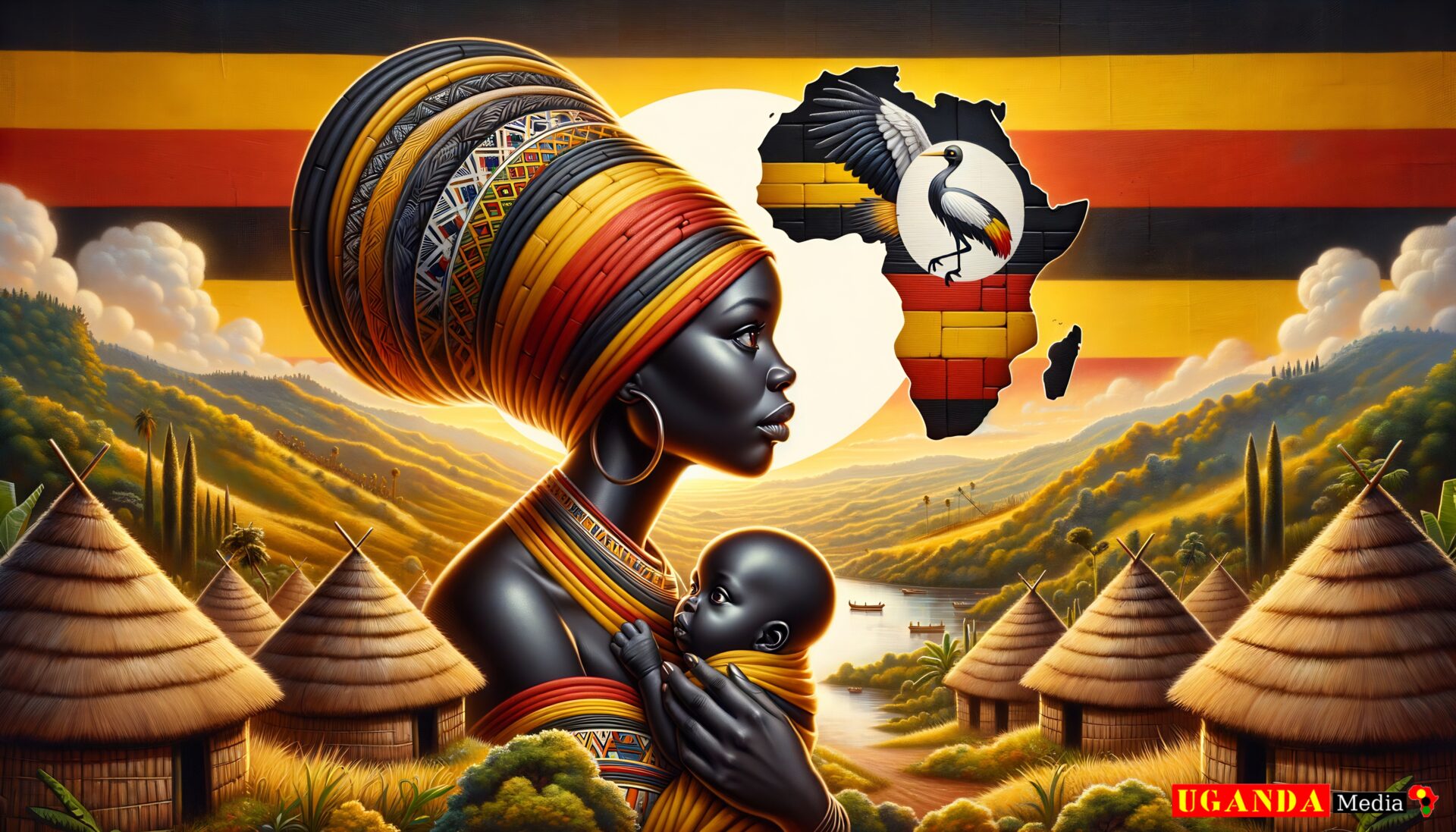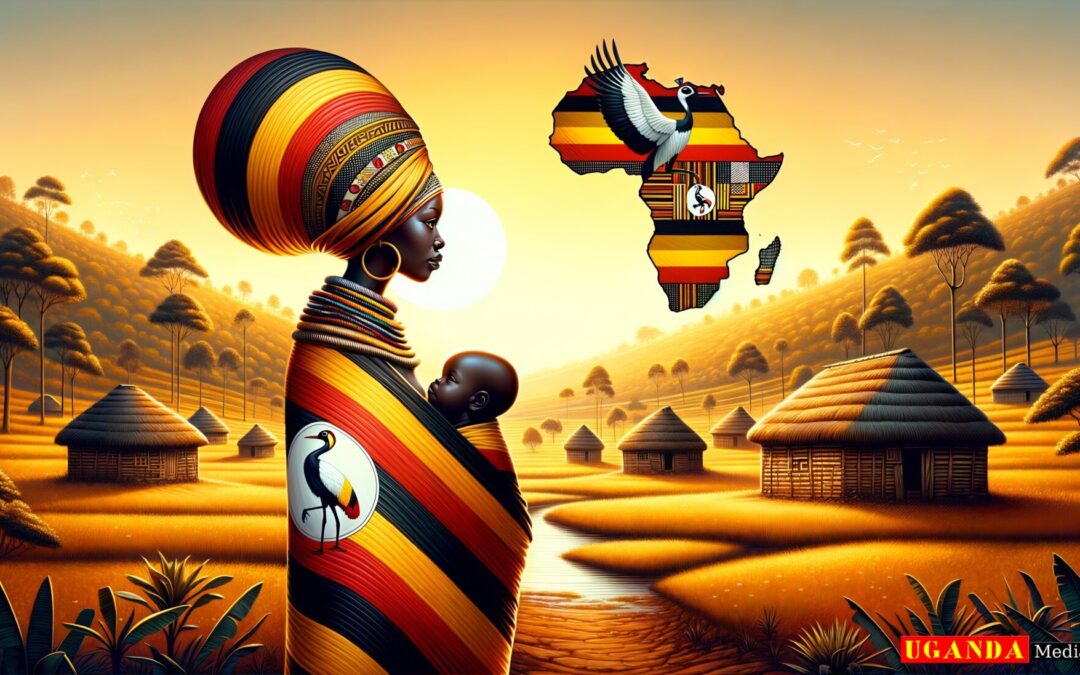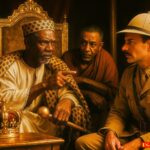Discover the Rich Cultural Heritage of the Logbara Tribe in North-Western Uganda
Nestled in the fertile plains of North-Western Uganda, the Logbara tribe boasts a vibrant tapestry of traditions, rituals, and beliefs that have shaped their way of life for centuries. From rain-making ceremonies beneath sacred trees to intricate rites of passage marking birth, marriage, and death, the Logbara offer a fascinating glimpse into a world where spirituality, community, and nature are deeply intertwined. Their practices, rooted in ancestral wisdom and Sudanic linguistic heritage, reflect a harmonious balance between tradition and the demands of modernity. As urbanisation, globalisation, and missionary influences pose challenges to preserving their cultural legacy, efforts to document and revitalise these customs highlight the resilience of the Logbara people. Explore the profound lessons this remarkable tribe imparts on sustainability, unity, and the enduring power of culture to inspire hope for the future.

The Historical Roots of the Logbara Tribe
Nestled in the verdant hills and fertile plains of North-Western Uganda, the Logbara people have cultivated a rich cultural heritage that stretches back through generations. Their origins, steeped in oral tradition and punctuated by moments of migration, conquest, and adaptation, offer a fascinating glimpse into the intricate tapestry of African history. To understand the Logbara is to embark on a journey through time—one that begins with their ancestral migrations from the North-West and reveals the profound influence of their Sudanic linguistic roots.
Migration from the North-West: A Story of Resilience and Adaptation
The Logbara trace their lineage to two principal groups who ventured southward from the North-Western regions of Africa. One group traversed the dense forests and rugged terrain via the western route, passing through territories now part of the Democratic Republic of Congo before settling in what is today Arua District in Uganda. The other group followed an eastern path, crossing the Kaya River near Arabba. These migrations were not mere movements across land; they represented quests for survival, expansion, and identity.
A particularly poignant reference point for the Logbara is “Kolo” or “Lulu,” a location often mentioned in their folklore as the place where they parted ways with their linguistic cousins, the Moru and Logo tribes. This separation was not necessarily one of conflict but rather an era of expansion—a natural divergence spurred by the search for arable land and new opportunities. Such stories underscore the adaptability of the Logbara, who thrived despite the challenges posed by unfamiliar landscapes and competing tribes.
Before European colonial intervention, the Logbara lived in small, fragmented communities scattered across the region. These groups frequently engaged in skirmishes, reflecting both the competitive nature of tribal life and the lack of centralized authority. Yet, even amidst these conflicts, there existed a shared understanding of kinship and mutual obligation—a testament to their enduring sense of unity despite apparent divisions.
Sudanic Linguistic Heritage: A Bond Beyond Borders
Philologically, the Logbara belong to the Sudanic language family, specifically falling under the Madi subgroup within the broader Moru-Madi cluster. This classification places them alongside neighbouring tribes such as the Moru and Logo, with whom they share mutually intelligible dialects. Language, therefore, serves as more than just a medium of communication for the Logbara; it acts as a living link to their ancestors and a marker of their distinct identity.
Dr. Tucker’s seminal work on Sudanic languages highlights the interconnectedness of these tribes, whose lands form a horseshoe-shaped arc stretching from Amadi in South Sudan through the northeastern corner of the Democratic Republic of Congo, into northwestern Uganda, and back toward Mongalla Province (now Equatorial Province). This geographical continuity has fostered a shared cultural consciousness among the Logbara and their neighbours, reinforcing bonds forged over centuries.
For instance, the Logbara’s use of terms like Adronga —referring both to spirits in general and the Great Spirit believed to be the creator of humanity—resonates deeply with spiritual concepts found among other Sudanic-speaking groups. This linguistic affinity extends beyond vocabulary to encompass values, rituals, and moral codes, all of which contribute to a collective memory that transcends individual clans or villages.
Shared History: The Foundation of Belonging
The Logbara’s historical narrative is not merely a chronicle of events; it is a dynamic repository of lessons, legends, and lived experiences that bind them together. Oral traditions, passed down through generations, recount tales of bravery during battles, wisdom displayed in divination ceremonies, and resilience demonstrated in times of drought. These stories are recounted during communal gatherings, harvest festivals, and rites of passage, ensuring that each successive generation remains connected to its past.
One such example is the recitation of the Adi, the tribe’s historical account, which is performed with great solemnity during significant ceremonies. Through this ritual, elders narrate the tribe’s triumphs and trials, drawing parallels between ancient struggles and contemporary challenges. The act of sharing these narratives fosters a profound sense of belonging among the Logbara, reminding them that their personal identities are intertwined with the larger fabric of their community.
Moreover, the physical markers of their history—such as sacred trees, ancestral shrines, and ceremonial stones—serve as tangible reminders of their journey. For instance, the otuke , quartz chips used in rain-making rituals, are cherished heirlooms handed down from father to son. Each stone carries with it the weight of countless prayers offered during periods of drought, symbolising the enduring hope and faith of the Logbara people.
A Legacy Etched in Time
In tracing the historical roots of the Logbara tribe, we uncover a story of resilience, adaptation, and unity. Their migration from the North-West laid the foundation for a vibrant culture shaped by both internal cohesion and external influences. Their Sudanic linguistic heritage underscores their connection to a wider network of tribes, while their shared history reinforces a collective identity rooted in memory and tradition.
As the Logbara continue to navigate the complexities of modern life in Uganda, their historical legacy remains a source of strength and inspiration. It reminds them—and us—that the past is never truly behind; it lives on in the customs we observe, the languages we speak, and the stories we tell. In preserving these elements, the Logbara ensure that their history continues to shape their future, fostering a sense of belonging that transcends time and geography.
Rites of Passage as Pillars of Identity: Connecting Individuals to Ancestors and Communities in Uganda’s Logbara Tribe
In the heart of North-Western Uganda, where rolling hills meet vast plains, the Logbara tribe has nurtured a cultural heritage deeply rooted in rites of passage. These ceremonies—marking birth, puberty, marriage, and death—are far more than symbolic gestures; they are fundamental pillars that shape individual identity while reinforcing bonds with ancestors and the wider community. For the Logbara, life is not merely a linear progression but a cyclical journey intertwined with spiritual meaning, communal responsibility, and ancestral wisdom.
Birth: Welcoming Life into the Sacred Circle
The arrival of a child among the Logbara is celebrated as both a gift from Adronga , the Great Spirit, and a continuation of their lineage. Birth rites serve as the first bridge between the newborn and the ancestral world. In cases of “normal” births, rituals are straightforward, focusing on integration into the family unit. However, for “abnormal” births such as twins or children born shortly after the death of a sibling (referred to as Egugu ), special ceremonies are conducted to protect the child from malevolent spirits.
For example, a banana tree is planted near the home, accompanied by offerings made by an elder woman wielding a rattle. This act symbolises the connection between the living and the departed, ensuring the child’s safe passage through life under the watchful eyes of ancestors. The shaving of the Egugu ‘s hair at around eight years old marks another milestone, culminating in feasts and sacrifices that further embed the child within the fabric of their clan. Through these rites, individuals are reminded of their place in a continuum stretching back generations.
Puberty: Transitioning into Adulthood
Among the Logbara, the transition from childhood to adulthood is marked by subtle yet significant changes. While explicit puberty rites may vary across clans, the underlying principle remains consistent: the individual must be prepared to assume adult responsibilities. This preparation often involves learning traditional skills, understanding moral codes, and participating in communal activities.
For young men, this period might include training in hunting or warfare, disciplines historically vital for survival. Young women, meanwhile, are taught domestic arts and the intricacies of social roles within the household. Both genders are encouraged to embody virtues like courage, loyalty, and respect—qualities revered in Logbara society. By linking these transitions to ancestral teachings, the tribe ensures that each new generation carries forward shared values and collective memory.
Marriage: Uniting Families and Strengthening Bonds
Marriage among the Logbara is not just a union of two individuals but a fusion of families and clans. It represents a cornerstone of communal cohesion, celebrating the interconnectedness of all members. Wedding ceremonies are vibrant affairs characterised by song, dance, and symbolic acts designed to forge lasting alliances.
In some clans, such as Omugo, the groom’s relatives journey to the bride’s village in a joyous procession, singing and dancing their way to her home. Upon arrival, playful yet meaningful customs unfold, including the smearing of cow dung on a representative of the groom’s party—a ritual said to ward off misfortune. Once the bride is escorted to her new home, she is ceremonially raised above heads, gazing skyward, signifying her elevated status and divine blessing. Such elaborate displays underscore the importance of marriage as a rite that strengthens communal ties and perpetuates ancestral traditions.
Death: Honoring the Departed and Ensuring Continuity
Death, though sombre, is viewed by the Logbara as a natural phase in the cycle of existence. Funeral rites are meticulously observed to honour the deceased and facilitate their journey into the ancestral realm. These ceremonies also serve to comfort the bereaved, reaffirming their connection to those who have passed.
Ancestral shrines play a central role in mourning practices, providing spaces for offerings and prayers. Elders recount the Adi , the tribe’s oral history, during these gatherings, weaving tales of past triumphs and tribulations. This storytelling reinforces collective memory, reminding mourners of their shared heritage and resilience. By treating death with reverence and ritual, the Logbara ensure that the legacy of their ancestors continues to guide and inspire future generations.
The Broader Significance of Rites of Passage
These rites of passage are not isolated events but interconnected threads in the tapestry of Logbara life. Each ceremony serves as a milestone, grounding individuals in their cultural identity while fostering unity within the community. They provide opportunities for elders to impart wisdom, for peers to celebrate together, and for families to reinforce their bonds.
Moreover, these rites reflect broader African philosophies about life and death. Across the continent, similar traditions exist among diverse ethnic groups, highlighting universal themes of continuity, transformation, and belonging. For the Logbara, these rituals are essential tools for navigating life’s uncertainties, drawing strength from ancestral guidance and communal solidarity.
A Legacy That Endures
From birth to death, the rites of passage practised by the Logbara tribe stand as enduring testaments to the power of tradition in shaping human experience. They remind us that identity is not formed in isolation but through relationships—with ancestors, kin, and community. As modern influences continue to reshape Ugandan society, preserving these rituals becomes ever more crucial. They offer not only a sense of belonging but also timeless lessons in resilience, unity, and the sacred rhythms of life itself. Through these rites, the Logbara keep their past alive, ensuring it remains a beacon for generations to come.
The Mystical Role of Spirits in Daily Life: Adronga, the Great Spirit, and Its Influence on Everyday Decisions
In the lush savannahs and fertile plains of North-Western Uganda, where the Logbara people have thrived for generations, spirituality is not a mere abstraction but a living force woven into the fabric of daily existence. At the heart of this spiritual framework stands Adronga , the Great Spirit—a revered entity believed to be the creator of humanity and the ultimate arbiter of life’s mysteries. For the Logbara, Adronga and other spirits play an indispensable role in guiding decisions, shaping rituals, and fostering a sense of continuity between the living, the departed, and the divine. From naming ceremonies to protective rites for children, the influence of these mystical forces permeates every aspect of their lives, offering both solace and direction in a world fraught with uncertainties.
Adronga: The Embodiment of Creation and Guidance
To the Logbara, Adronga is both singular and plural, encompassing all spirits while simultaneously representing the supreme deity. This dual nature underscores the tribe’s belief in a cosmos teeming with spiritual entities that influence human affairs. Adronga is not distant or detached; rather, it is deeply embedded in the rhythms of everyday life. As the creator of mankind, Adronga is invoked during pivotal moments—birth, marriage, death, and even mundane activities like sowing seeds or embarking on a hunt.
The omnipresence of Adronga ensures that no decision is made lightly. For instance, before venturing into battle or undertaking significant tasks, elders consult the spirit through divination practices such as Büro or Qbagba . These rituals serve as conduits for seeking divine approval or foretelling outcomes, reflecting humanity’s enduring quest for certainty amidst chaos. By acknowledging Adronga ’s authority, the Logbara affirm their place within a larger cosmic order—an order governed by balance, respect, and reciprocity.
Naming Ceremonies: A Sacred Connection to Ancestral Identity
One of the most profound ways in which Adronga influences daily life is through naming ceremonies. Among the Logbara, names are more than labels; they are vessels of identity, carrying the weight of ancestral legacies and spiritual significance. When a child is born, particularly under unusual circumstances (such as being an Egugu , or “survivor” of a deceased sibling), specific rites are performed to invoke Adronga ’s protection.
Take, for example, the case of an Egugu . This child, believed to carry the lingering presence of their departed sibling, undergoes elaborate ceremonies designed to shield them from malevolent forces. A banana tree is planted near the home, accompanied by offerings made by an elder woman wielding a rattle. As she smears the child with food and chants incantations, she calls upon Adronga to cleanse the infant and grant them safe passage through life. Such rituals highlight how deeply intertwined spirituality is with identity formation, ensuring that each child is anchored in both familial and spiritual lineages.
Protective Rituals for Children: Safeguarding the Vulnerable
Children occupy a special place in Logbara society, viewed as bridges between past and future generations. However, childhood is also seen as a vulnerable period, requiring constant vigilance against unseen threats. Here again, Adronga plays a central role in safeguarding young lives.
For instance, the ceremonial shaving of an Egugu ’s hair at around eight years old is laden with symbolic meaning. Until this age, the child’s hair is allowed to grow long, braided into red tresses smeared with ochre—a practice believed to ward off harmful spirits. During the shaving ceremony, relatives gather to celebrate the child’s transition into a new phase of life. Sacrifices are made to ancestral shrines, invoking Adronga ’s blessings for prosperity and well-being. Through these acts, the community reaffirms its collective responsibility to nurture and protect its youngest members, guided by the wisdom of their ancestors and the favour of the Great Spirit.
Rain-Making and Agricultural Cycles: Appeasing Adronga for Survival
Beyond personal milestones, Adronga ’s influence extends to communal endeavours critical for survival, such as agriculture. In a region prone to periods of drought, rain-making rituals hold immense importance. The opi-ozogo dri (rain-makers) are revered figures entrusted with maintaining harmony between humans and nature. Central to their craft are sacred stones known as otuke , believed to possess mystical powers capable of summoning rainfall.
These stones, handed down from father to son, are treated with utmost reverence. Should one go missing, immediate recourse is made to divination ceremonies to locate it, underscoring the belief that neglecting Adronga ’s intermediaries could invite disaster. By performing these rituals under sacred trees, the rain-makers appeal to Adronga for mercy and sustenance, reinforcing the tribe’s reliance on spiritual intervention to navigate environmental challenges.
Ethical Framework: Living in Accordance with Adronga ’s Teachings
The concept of Adronga also serves as a moral compass, shaping behavioural norms and ethical codes among the Logbara. Courage, loyalty, respect for elders, and communal solidarity are virtues instilled through stories, songs, and ceremonies honouring the Great Spirit. These teachings remind individuals of their duty to uphold societal values while fostering unity within the community.
For example, during disputes over issues like land or livestock, resolution often involves appealing to Adronga for guidance. Elders recount the tribe’s oral history—the Adi —during such gatherings, drawing parallels between ancient conflicts and contemporary grievances. By framing modern dilemmas within a spiritual context, the Logbara ensure that solutions align with timeless principles rooted in tradition and faith.
Broader Implications: Spirituality as a Unifying Force
The mystical role of spirits like Adronga transcends individual households, binding the entire community together. Whether through shared rituals, communal sacrifices, or collective storytelling, these practices foster a sense of belonging and mutual obligation. In a broader African context, similar beliefs exist across diverse ethnic groups, highlighting universal themes of interconnectedness and reverence for the unseen.
For the Logbara, Adronga represents not just a deity but a unifying force that sustains their cultural identity. In an era marked by rapid change and external pressures, preserving these traditions becomes crucial. They offer not only a source of strength but also a reminder of humanity’s enduring connection to something greater than itself—a connection that transcends time and geography.
Echoes of the Divine in Everyday Life
The Logbara’s relationship with Adronga exemplifies how spirituality can infuse even the simplest acts with profound meaning. From naming ceremonies to protective rites, agricultural cycles to ethical frameworks, the Great Spirit looms large over their daily decisions, providing guidance, comfort, and purpose. As modernity continues to reshape Ugandan society, the Logbara’s reverence for Adronga serves as a poignant reminder of the enduring power of faith to anchor us in turbulent times. In embracing these traditions, they preserve not just their past but a vision of the future—one rooted in unity, resilience, and the eternal rhythms of life itself.
Rain-Making: Bridging Science and Spirituality
Analyzing the Role of Rain-Makers (opi-ozogo dri ) and Sacred Stones (otuke ) in Uganda’s Logbara Tribe
In the sun-drenched plains of North-Western Uganda, where agriculture remains the backbone of life, rain is not merely a meteorological phenomenon—it is a lifeline. For the Logbara people, whose existence hinges on the success of their crops, the absence of rainfall brings with it the spectre of famine, hardship, and despair. It is within this context that rain-making rituals emerge as a profound intersection of science and spirituality. The rain-makers, known as opi-ozogo dri (“masters of the rain”), and the sacred stones called otuke , play pivotal roles in addressing environmental challenges like drought while reinforcing cultural identity and communal solidarity.

The Role of Rain-Makers (opi-ozogo dri )
The opi-ozogo dri are revered figures in Logbara society, entrusted with maintaining harmony between humanity and nature. Their title reflects both their authority and their sacred duty to ensure the timely arrival of rain. These individuals are not self-appointed but are chosen through lineage or divination, signifying their connection to ancestral wisdom and divine favour.
When periods of drought threaten the land, the community turns to the opi-ozogo dri without hesitation. Their role extends beyond mere ritualistic performance; they serve as intermediaries between the physical and spiritual realms, invoking the blessings of Adronga , the Great Spirit, for relief from parched earth. The process begins under sacred trees—often referred to as Joko —where shrines dedicated to rain-making stand as symbols of reverence. Here, the rain-maker performs elaborate ceremonies involving offerings, prayers, and symbolic acts designed to appease the spirits and coax rainfall from the heavens.
What makes the opi-ozogo dri particularly fascinating is how their practices blend empirical observation with spiritual belief. For instance, their rituals often coincide with seasonal patterns observed over generations. By aligning ceremonies with natural cycles, they demonstrate an intuitive understanding of ecological dynamics—a form of indigenous knowledge passed down through oral tradition. This synthesis of observation and faith underscores the Logbara’s holistic approach to environmental stewardship.
The Sacred Stones (otuke ): Guardians of Rainfall
Central to the rain-making ceremonies are the otuke , small chips of quartz polished to a smooth sheen and imbued with mystical significance. These stones are considered precious heirlooms, handed down from father to son, and are treated with utmost care. According to Logbara beliefs, the loss or misplacement of even a single otuke can precipitate drought, underscoring their perceived power over climatic conditions.
The otuke are typically stored in granaries or calabashes near sacred trees, ensuring they remain damp during the cultivation season—a practice believed to sustain their efficacy. Should one go missing, immediate recourse is made to divination rituals to locate it. This underscores the deep trust placed in these stones as guardians of rainfall. Remarkably, local lore suggests that the otuke possess almost sentient qualities—they may “fly away” if neglected or generate new stones when properly cared for. Such tales highlight the animistic worldview of the Logbara, wherein objects are seen as extensions of the spiritual realm.
From a scientific perspective, the emphasis on keeping the otuke moist could be interpreted as an early recognition of humidity’s role in precipitation. While modern meteorology explains rainfall through atmospheric processes, the Logbara’s reliance on the otuke illustrates how traditional societies developed practical solutions rooted in symbolic frameworks. This duality—combining spiritual conviction with pragmatic action—offers valuable insights into sustainable resource management.
Cultural Importance Against Environmental Challenges
Drought poses a significant threat to agricultural communities across Africa, and the Logbara are no exception. In a region where irrigation systems are limited and dependence on rain-fed farming is nearly absolute, the failure of rains can have catastrophic consequences. Against this backdrop, the cultural importance of rain-making cannot be overstated. It serves as both a coping mechanism and a source of hope, providing psychological comfort during times of crisis.
For the Logbara, rain-making is not a solitary endeavour but a communal responsibility. When drought looms, entire villages gather under sacred trees to participate in ceremonies led by the opi-ozogo dri . These gatherings foster unity and reinforce social bonds, reminding participants of their shared vulnerability and collective strength. Moreover, the rituals themselves often involve redistributive practices, such as sharing food and resources, which help mitigate the impact of scarcity.
The use of otuke further amplifies the cultural significance of rain-making. As tangible representations of ancestral wisdom, these stones link the present generation to its forebears, creating a sense of continuity amidst uncertainty. They also embody the Logbara’s respect for the environment, encouraging careful stewardship of natural resources. By attributing agency to the stones, the tribe instils a sense of accountability among its members, urging them to act responsibly toward the land.
A Broader Perspective: Lessons from Indigenous Knowledge
The rain-making traditions of the Logbara offer more than just cultural insight—they provide lessons applicable to contemporary environmental challenges. In an era marked by climate change and increasing water scarcity, there is much to learn from indigenous practices that harmonise human activity with ecological rhythms. The Logbara’s integration of spiritual beliefs with empirical observations demonstrates the potential for coexistence between tradition and innovation.
Furthermore, the communal aspect of rain-making highlights the importance of collective action in addressing environmental issues. Modern conservation efforts often emphasise individual responsibility, yet the Logbara model reminds us that sustainability is fundamentally a shared endeavour. By drawing upon shared values and mutual obligations, communities can mobilise resources and resilience in ways that transcend individual capacities.
Honouring the Sacred Rhythms of Nature
Rain-making among the Logbara tribe exemplifies the intricate interplay between science and spirituality, tradition and necessity. Through the revered figure of the opi-ozogo dri and the mystical properties attributed to the otuke , the Logbara navigate the uncertainties of drought with dignity and determination. Their practices reflect not only a deep understanding of their environment but also an unwavering commitment to preserving their way of life.
As global conversations about climate adaptation gain momentum, the rain-making rituals of the Logbara stand as a testament to the enduring relevance of indigenous knowledge. They remind us that solutions to environmental challenges must honour the sacred rhythms of nature while fostering unity and resilience within communities. In bridging science and spirituality, the Logbara illuminate a path forward—one that respects the past while embracing the future.
Marriage Customs: Celebrating Unity Through Tradition
Narrating the Vibrant Wedding Processions Involving Song, Dance, and Symbolic Acts in Uganda’s Logbara Tribe
In the verdant hills of North-Western Uganda, where the rhythms of life are dictated by the seasons and the bonds of community run deep, marriage among the Logbara tribe is far more than a union between two individuals—it is a celebration of unity, an affirmation of shared values, and a testament to the power of tradition. The vibrant wedding processions that accompany these ceremonies are a kaleidoscope of song, dance, and symbolic acts, each imbued with meaning and purpose. These rituals unite two families and reinforce the communal ethos that lies at the heart of Logbara society.
The Journey to Fetch the Bride: A Festive Commencement
The wedding ceremony begins with the groom’s family embarking on a joyous procession to fetch the bride from her village—a journey steeped in symbolism and camaraderie. Among clans such as Omugo, this expedition transforms into a lively spectacle of singing and dancing, as relatives of the groom march together toward the bride’s home. Clad in traditional attire, they weave through fields and pathways, their voices harmonising in celebratory chants that echo across the landscape. This act of collective participation underscores the communal effort required to bring two families together, turning what could be a private affair into a public declaration of solidarity.
Upon arrival, the procession encounters a playful yet meaningful ritual designed to test their resolve and humility. At the entrance to the bride’s compound, a layer of cow dung is spread across the ground. Here, one of the groom’s male relatives—or, failing that, the groom’s father—is ceremonially seized and gently pressed face-down onto the dung. His body is then smeared with it, symbolising submission and respect for the bride’s family. Should no willing participant step forward, the father of the groom must take on this role himself, lying prone near the threshold of the hut.
As the door opens, the bride and her companions emerge one by one, stepping lightly over the prostrate figure—first placing a foot on his head, then another on his back—before proceeding into the courtyard. This ritual serves multiple purposes: it humbles the groom’s party, honours the bride as she transitions into her new role, and injects levity into the proceedings, reminding everyone present that marriage is both solemn and joyful.
The Bride’s Triumphal Entry: Elevated Toward Heaven
Once the initial playfulness subsides, the focus shifts to the bride herself, who becomes the centerpiece of the celebration. Her relatives hand her over to the groom’s family, who hoist her high above their heads so that she gazes skyward—a gesture laden with spiritual significance. By raising her heavenward, the community acknowledges her elevated status as a bride and invokes blessings from the divine realm. As they carry her back to the groom’s village, the procession resumes its festive energy, punctuated by laughter, music, and occasional stops along the way.
At river crossings or other significant points, the entourage halts briefly, allowing the bride’s father to demonstrate his generosity by offering coins or small gifts to the groom’s family. If he neglects this duty, he may receive a symbolic stick—a lighthearted reminder to fulfill his obligations during future visits. These moments of interaction highlight the reciprocity inherent in Logbara marriage customs, ensuring that both families contribute to the success of the union.
Arrival at the Groom’s Village: Chaos and Celebration
When the procession finally reaches the groom’s village, the atmosphere shifts once again, this time marked by controlled chaos and exuberance. The women accompanying the bride unleash their pent-up energy, dashing about the compound to “destroy” whatever items have been left out for them—typically sacrificial goats, chickens, or household objects deemed dispensable. This playful destruction serves as a symbolic cleansing of the past, making way for the couple’s new beginning. Meanwhile, preparations begin for a feast featuring freshly slaughtered livestock, roasted meats, and locally brewed beer—an indispensable element of any Logbara celebration.
Amidst the revelry, the individual who was earlier covered in cow dung undergoes a ceremonial washing, followed by anointing with oil. This transformation from humiliation to honour mirrors the broader themes of renewal and reconciliation central to the marriage rite. The day concludes with feasting, drinking, and merrymaking, as the entire community comes together to celebrate the newlyweds’ union.
Symbolism and Communal Effort: The Essence of Logbara Weddings
What sets Logbara weddings apart is their emphasis on communal involvement and symbolic gestures. Every aspect of the ceremony—from the groom’s procession to the bride’s triumphant entry—carries layers of meaning, reflecting the tribe’s belief in interconnectedness and mutual obligation. For instance, the use of cow dung in welcoming rituals highlights the importance of agriculture and fertility, while the act of raising the bride skyward evokes notions of divine blessing and protection. Similarly, the sharing of food and drink reinforces social bonds, ensuring that no member of the community feels excluded from the joyous occasion.
These traditions also serve practical purposes. By requiring active participation from both families, the wedding fosters goodwill and minimises potential conflicts. Elders play a crucial role in mediating disputes and guiding younger generations through the intricacies of marital customs, thereby preserving cultural continuity. Moreover, the inclusion of divination practices like Büro or Qbagba ensures that decisions align with ancestral wisdom, further solidifying the spiritual foundation of the union.
Broader Implications: A Model of Communal Solidarity
The Logbara approach to marriage offers valuable insights into how African societies navigate the complexities of human relationships. In many ways, their customs mirror those found across the continent, where weddings are viewed as opportunities to strengthen communal ties and uphold cultural heritage. Whether through elaborate dowry negotiations, symbolic rites, or collective celebrations, these traditions remind participants of their responsibilities to one another and to future generations.
In an era marked by rapid urbanisation and globalisation, the preservation of such customs becomes increasingly important. They provide not only a sense of identity and belonging but also a framework for addressing contemporary challenges. For instance, the emphasis on communal effort in Logbara weddings reflects timeless principles of cooperation and reciprocity—principles that remain relevant in fostering resilience within modern communities.
A Celebration of Togetherness
Marriage among the Logbara tribe is a vivid tapestry of tradition, symbolism, and communal spirit. From the spirited processions to the intricate rituals, every detail is carefully crafted to honour the past, celebrate the present, and ensure the future prosperity of the couple and their extended families. Through song, dance, and shared experiences, the Logbara remind us that marriage is not merely a personal milestone but a collective endeavour—one that binds individuals, families, and communities in a web of enduring connections. In embracing these traditions, they preserve not just their cultural heritage but a vision of unity and harmony that transcends time and geography.
Warfare and Leadership Among the Logbara: A Reflection on Historical Conflicts, the Role of Warriors (Ombasa ), and Ceremonial Sacrifices
In the rugged plains of North-Western Uganda, where the Logbara people have carved out their existence for centuries, warfare has been both a tool of survival and a testament to resilience. The tribe’s history is punctuated by conflicts—some minor skirmishes over land or personal grievances, others larger-scale battles driven by external threats or internal disputes. These clashes reveal not only the Logbara’s capacity for conflict but also their remarkable ability to reconcile differences when unity becomes imperative. At the heart of these dynamics lies the figure of the warrior-leader, known as Ombasa , whose role extended beyond combat to embody leadership, strategy, and spiritual guidance. Equally, significant are the ceremonial sacrifices made before battles, which underscored the Logbara’s belief in divine intervention and collective effort.
Historical Context: From Tribal Skirmishes to Colonial Encounters
The Logbara’s historical accounts suggest that large-scale wars against other tribes were relatively rare. Instead, most conflicts arose within the tribe itself, often between clans competing for resources, women, or prestige. Disputes over marriage, particularly cases involving adultery or abduction, frequently escalated into violence. In such instances, revenge killings were commonplace; if one man was murdered, his relatives would retaliate by taking the life of someone from the perpetrator’s clan. This cycle of vengeance perpetuated feuds that could span generations, highlighting the deeply ingrained sense of familial obligation among the Logbara.
However, the arrival of European colonial powers marked a turning point in the tribe’s martial history. Older men vividly recall the resistance mounted against Emin Pasha’s soldiers, Belgian forces referred to as Tukutuku , and later, the British administration. These encounters exposed the Logbara to new forms of warfare and weaponry, challenging their traditional methods of combat. Despite this, they retained their characteristic bravery, earning admiration even from colonial officers who noted the warriors’ tenacity and skill.
One notable aspect of Logbara warfare is their adaptability. Although the tribe lacked centralized authority, with various clans operating under their respective chiefs, they demonstrated an uncanny ability to unite during times of crisis. This cohesion underscores a broader African philosophy: in union lies strength. When faced with external threats, disparate clans set aside petty rivalries to fight as one cohesive force—a lesson in collective solidarity that remains relevant today.
The Role of Warriors (Ombasa ): Leaders in Battle and Beyond
At the forefront of every Logbara battle stood the Ombasa, a title bestowed upon the leader of warriors. Unlike the hereditary chiefs who governed daily affairs, the Ombasa earned his position through acts of courage, strategic acumen, and proven loyalty to the community. His responsibilities extended far beyond leading troops into battle; he served as a mediator, motivator, and spiritual conduit, ensuring that both warriors and civilians remained aligned with ancestral traditions and divine favour.
Before embarking on any military campaign, the Ombasa played a pivotal role in organizing ceremonial sacrifices aimed at securing victory. These rituals typically took place beneath sacred trees, such as the Adugu, where shrines dedicated to war deities were located. The bows and arrows of warriors were placed at the base of the tree, symbolizing their submission to higher powers. Elders then conducted divination practices, akin to Büro or Qbagba, to ascertain whether the spirits favoured the impending battle. If omens were auspicious, the Ombasa delivered rousing speeches (awi or ad’i) to inspire his men, invoking memories of fallen kin and promising divine assistance.
During combat, the Ombasa led by example, wielding traditional weapons like bows, arrows, and spears with deadly precision. Archery was the primary mode of attack, allowing warriors to maintain distance from their enemies until close quarters necessitated the use of spears. Their tactical approach reflected a blend of aggression and caution, honed through years of experience in localized skirmishes.
After the battle, the Ombasa transitioned into a peacemaker, facilitating negotiations between warring factions to prevent further bloodshed. This dual role highlights the complexity of Logbara leadership, where the same individual responsible for instigating conflict also bore the responsibility of fostering reconciliation—a delicate balancing act requiring wisdom, patience, and diplomacy.
Ceremonial Sacrifices: Invoking Divine Assistance
Ceremonial sacrifices formed an integral part of Logbara warfare, serving as bridges between the physical and spiritual realms. These rituals were meticulously observed, reflecting the tribe’s deep-seated belief that success in battle depended not solely on human prowess but also on divine intervention.
One common practice involved gathering beneath sacred trees, such as the Ujjo or Chiki , where warriors deposited their weapons as offerings to ancestral spirits. A senior elder presided over the ceremony, querying the spirits through divination techniques similar to those used in Büro . Leaves plucked from the sacred tree were moistened with saliva and sprinkled with the blood of a sacrificed animal, imbuing them with mystical power. These leaves were then waved over the warriors, cleansing them of impurities and endowing them with courage and protection.
In some regions, shrines known as Endrindria played a crucial role in wartime rituals. Comprising three small stones arranged around a larger one beneath a sacred tree, these shrines were believed to grant favour to those who offered sacrifices. Warriors sought blessings here before heading into battle, trusting that their devotion would tip the scales in their favour.
Such ceremonies reinforced communal bonds, reminding participants that warfare was not merely an individual endeavour, but a collective responsibility shared by all members of the tribe. By appealing to ancestral spirits and performing symbolic acts, the Logbara ensured that their actions aligned with cosmic order, thereby legitimizing their cause and bolstering morale.
Conflict and Reconciliation: A Dual Legacy
The Logbara’s martial traditions illuminate their dual capacity for conflict and reconciliation. On one hand, their readiness to engage in battle reflects a pragmatic understanding of survival in a harsh environment fraught with scarcity and competition. On the other hand, their willingness to unite across clan lines and resolve disputes through negotiation demonstrates a profound commitment to preserving social harmony.
This duality resonates with broader African philosophies about justice and restoration. For instance, the emphasis on restorative practices—such as compensatory payments or public apologies—mirrors principles found in other indigenous legal systems across the continent. Rather than perpetuating cycles of vengeance, the Logbara recognized the importance of closure and healing, ensuring that communities could move forward without lingering animosities.
Moreover, their approach to leadership offers valuable insights into effective governance. The Ombasa exemplifies the ideal of servant-leadership, prioritizing the welfare of the community above personal ambition. By combining martial skills with diplomatic finesse, these leaders embodied the qualities necessary to navigate the complexities of tribal politics.
Broader Implications: Lessons for Modern Societies
The Logbara’s experiences with warfare and leadership carry timeless lessons applicable to contemporary contexts. In an era marked by global conflicts and societal fragmentation, their emphasis on unity and reconciliation serves as a powerful reminder of humanity’s shared destiny. Just as the Logbara rallied together in times of crisis, modern communities must learn to transcend divisions and work toward common goals.
Furthermore, the ceremonial sacrifices highlight the enduring relevance of spirituality in shaping human behaviour. While technological advancements have transformed the nature of warfare, the underlying need for purpose and meaning remains unchanged. By acknowledging the interconnectedness of physical and metaphysical realms, societies can cultivate a more holistic approach to conflict resolution.
Honouring the Warrior’s Path
Warfare among the Logbara was never undertaken lightly; it was a solemn undertaking steeped in ritual, symbolism, and communal effort. Through the leadership of the Ombasa and the performance of ceremonial sacrifices, the tribe navigated the complexities of conflict while preserving its cultural identity. Their legacy reminds us that true strength lies not in domination but in the ability to balance aggression with compassion, division with unity, and tradition with innovation.
As we reflect on the Logbara’s martial heritage, we are reminded of the enduring power of storytelling, ritual, and shared values in forging resilient communities. In honouring their past, we find inspiration for our future—a future rooted in peace, cooperation, and mutual respect.
Divination Practices: Seeking Guidance from Beyond
Introducing Methods Like Büro and Qbagba : How the Logbara Seek Divine Approval or Foretell Outcomes
In the heart of North-Western Uganda, where the rhythms of life are dictated by the seasons and the spirits hold sway over human affairs, divination stands as a cornerstone of decision-making among the Logbara people. Through methods such as Büro and Qbagba , the Logbara seek to bridge the gap between the mortal and the divine, seeking guidance, approval, or foreknowledge of outcomes in matters both mundane and monumental. These practices reveal not only the tribe’s spiritual worldview but also humanity’s timeless quest for certainty amidst the uncertainties of existence.
The Essence of Divination Among the Logbara
For the Logbara, divination is more than mere superstition—it is a sacred dialogue with unseen forces that govern their lives. Whether consulting ancestral spirits, invoking deities like Adronga (the Great Spirit), or deciphering omens through symbolic acts, divination serves as a tool for navigating challenges ranging from personal dilemmas to communal crises. Central to this process are two prominent methods: Büro and Qbagba. Each method employs distinct techniques yet shares the same underlying purpose—to provide clarity and direction when faced with ambiguity.
Büro : Unveiling Hidden Truths Through Ritual Inquiry
Büro is one of the most widely practised forms of divination among the Logbara, often employed during critical junctures such as disputes, marriage negotiations, or preparations for war. The ritual typically unfolds beneath sacred trees—such as the Joko or Chiki —where shrines dedicated to ancestral spirits reside. Here, elders gather to pose questions to the spirit realm, using specific objects imbued with symbolic meaning.
A key component of Büro involves the use of small stones placed in a circular formation, each representing an individual present at the ceremony. A chicken is then sacrificed at the centre of the circle, its blood serving as an offering to invoke divine insight. Elders interpret the behaviour of the chicken before and after death, along with the arrangement of the stones, to determine guilt, innocence, or favourable courses of action. This method reflects the Logbara’s belief in the interconnectedness of all things; even seemingly random patterns carry profound significance.
One notable application of Büro occurs during rain-making ceremonies, particularly when locating missing otuke (sacred quartz chips). If drought threatens the land, and it is suspected that a stone has been misplaced or stolen, the community turns to Büro to identify the culprit. The accused must either produce the lost stone or face severe social consequences. Such rituals underscore the practical utility of divination, blending spiritual inquiry with real-world problem-solving.
Qbagba : Peering Into the Future Through Symbolic Acts
While Büro focuses on uncovering hidden truths, Qbagba is primarily concerned with predicting future events. This method relies heavily on symbolic gestures and natural phenomena to convey messages from the spirit world. For instance, hunters seeking success in their expeditions may consult Qbagba by marking themselves with red clay crosses on their temples—an act believed to attract divine favour. Similarly, warriors preparing for battle might perform similar rites beneath sacred trees, laying down their bows and arrows as offerings while imploring spirits for victory.
The interpretation of signs in Qbagba requires in-depth knowledge passed down through generations. Leaves plucked from sacred trees, moistened with saliva, and sprinkled with animal blood become conduits of prophecy. Elders examine how these leaves fall or adhere to surfaces, drawing conclusions about impending outcomes. In times of conflict, warriors scrutinise the bowstrings of their weapons—if brittle or broken, it signals readiness for war; if intact, they heed caution and refrain from aggression.
This reliance on symbolic acts highlights the Logbara’s holistic understanding of existence, wherein every element of nature—from trees to animals—is imbued with spiritual agency. By observing and interpreting these elements, the tribe gains confidence in their decisions, knowing they align with cosmic order.
Humanity’s Timeless Search for Certainty
At its core, divination among the Logbara illustrates humanity’s enduring need for reassurance in uncertain times. Across cultures and epochs, humans have sought ways to peer beyond the veil of mortality, whether through astrology, tarot cards, or modern data analytics. For the Logbara, Büro and Qbagba serve as culturally specific expressions of this universal impulse—a means of confronting life’s complexities with wisdom drawn from both experience and faith.
Consider, for example, the parallels between Logbara divination and broader African traditions. Many ethnic groups across the continent employ similar methods, such as throwing bones or shells to read patterns, echoing the Logbara’s use of stones and leaves. These shared practices suggest a common recognition of humanity’s vulnerability and dependence on higher powers—or perhaps on the collective unconscious—for guidance.
Moreover, divination provides psychological comfort, fostering resilience in the face of adversity. When crops fail due to drought, when conflicts arise over land or livestock, or when illness strikes unexpectedly, the Logbara turn to divination not out of despair but as a proactive step toward resolution. By framing problems within a spiritual context, they transform uncertainty into opportunity, finding strength in their connection to ancestors and the divine.
Broader Implications: Lessons for Modern Society
The Logbara’s divinatory practices offer valuable insights into contemporary debates about science, spirituality, and decision-making. While modern societies increasingly prioritise empirical evidence and rational analysis, there remains an undeniable yearning for deeper meaning—a desire to reconcile logic with intuition, facts with faith. Divination bridges these realms, reminding us that knowledge arises not solely from observation but also from introspection and imagination.
Furthermore, the communal aspect of Büro and Qbagba underscores the importance of collective wisdom in addressing challenges. Unlike individualistic approaches prevalent today, these rituals emphasise collaboration, ensuring that decisions reflect the input of multiple voices rather than solitary judgment. This principle resonates strongly in an era marked by polarisation and fragmentation, urging us to rediscover the power of shared deliberation.
Conclusion: Bridging Worlds Through Divination
Through methods like Büro and Qbagba , the Logbara reveal their profound respect for the unseen forces that shape their destiny. These practices are not relics of a bygone age but living traditions that continue to guide individuals and communities through life’s trials. By seeking divine approval or foretelling outcomes, the Logbara affirm their place within a larger cosmic narrative—one that transcends time and geography.
As we reflect on their divinatory customs, we are reminded of humanity’s eternal longing for certainty and connection. Whether through ancient rituals or cutting-edge technologies, our search for answers persists, driven by the hope that somewhere, somehow, the mysteries of existence can be unravelled. In embracing this quest, the Logbara inspire us to look beyond surface-level solutions and delve deeper into the sacred rhythms that bind us all together.
Gender Roles and Women’s Rituals: Highlighting Unique Rites Reserved for Women in the Logbara Tribe
In the lush plains of North-Western Uganda, where the Logbara people have thrived for generations, gender roles are not merely social constructs but deeply embedded expressions of cultural identity. Among the Logbara, women play a vital role in maintaining societal cohesion and ensuring spiritual continuity through unique rites and rituals that underscore their contributions to the community. These ceremonies, reserved specifically for women, highlight their agency, resilience, and centrality in upholding the tribe’s traditions. From rites of passage to agricultural ceremonies, women’s rituals serve as bridges between the physical and spiritual realms, reinforcing the interconnectedness of all aspects of Logbara life.
The Distinctive Role of Women in Logbara Society
In Logbara culture, gender roles are defined yet complementary, with men and women sharing responsibilities that sustain the tribe’s social and spiritual fabric. While men often take on leadership roles in warfare, hunting, and rain-making, women are entrusted with nurturing families, managing households, and performing rituals that ensure fertility, prosperity, and harmony. Their roles are not subordinate but rather integral to the functioning of the community, as they embody values such as patience, compassion, and resilience—qualities revered in Logbara society.
Women’s rituals are particularly significant because they address themes central to human existence: birth, growth, sustenance, and renewal. These rites celebrate femininity and affirm the divine connection between women and the natural world—a relationship symbolised by their involvement in ceremonies tied to agriculture, childbirth, and ancestral veneration.
Rites of Passage for Women: Celebrating Femininity and Responsibility
One of the most profound rites reserved for women is associated with puberty and the transition into adulthood. Although less elaborate than male initiation rites, these ceremonies mark a girl’s readiness to assume adult responsibilities, including marriage and motherhood. Elders guide young women through this process, teaching them the intricacies of domestic life, social etiquette, and moral codes.
For example, girls learn the art of brewing traditional beer (dofara), a skill that holds both practical and symbolic significance. Beer is not merely a beverage, but a sacred offering used in religious ceremonies, including those involving ancestral shrines. By mastering this craft, women contribute directly to the tribe’s spiritual practices, ensuring that rituals are performed with precision and reverence. This underscores the dual role of women as caretakers of the household and custodians of cultural heritage.
Childbirth and the Care of Egugu : Protecting Vulnerable Lives
Women occupy a central position in childbirth-related rituals, particularly those involving Egugu , children believed to carry the lingering presence of deceased siblings. As primary caregivers, women are responsible for safeguarding these vulnerable infants through protective rites. For instance, when an Egugu is born, it is typically an elderly woman—a respected figure within the community—who performs the necessary ceremonies.
The planting of a banana tree near the home, accompanied by offerings made with a rattle, exemplifies the maternal instinct to shield and nurture. During these rituals, the elder woman smears the child with food and chants incantations, calling upon Adronga , the Great Spirit, to cleanse and protect the infant. This act highlights the symbiotic relationship between women and the spiritual realm, as they mediate between the living and the ancestors to ensure the child’s safe passage through life.
The shaving of the Egugu ’s hair at around eight years old is another milestone overseen by women. Until this age, the child’s hair is allowed to grow long, braided into red tresses smeared with ochre—a practice believed to ward off harmful spirits. Women play a pivotal role in preparing the child for this ceremony, which culminates in feasts and sacrifices that further embed the child within the fabric of their clan. Through these acts, women reinforce familial bonds and spiritual continuity, ensuring that each generation remains connected to its past.
Agricultural Ceremonies: Honouring Women as Stewards of the Land
Agriculture is the cornerstone of Logbara life, and women are indispensable participants in the seasonal cycles that govern planting, cultivation, and harvest. Their involvement extends beyond physical labour to include ritualistic acts that invoke divine blessings for bountiful yields. For instance, during sowing season, women lead ceremonies aimed at appeasing ancestral spirits and securing favourable weather conditions.
One such ritual involves offerings made beneath sacred trees, where women place grains, vegetables, and other symbolic items as tokens of gratitude and supplication. These acts reflect the Logbara belief in the interconnectedness of humans, nature, and the divine—a worldview in which women serve as mediators. By participating in these ceremonies, women affirm their role as stewards of the land, ensuring that agricultural practices align with ancestral teachings and ecological balance.
Harvest-time celebrations further showcase women’s contributions to societal cohesion. As primary preparers of food, women oversee the preparation of communal meals, including dishes made from millet, beans, and sesame seeds. These feasts bring the community together, fostering unity and reinforcing social bonds. Moreover, women brew beer (dofara ) used in celebratory rituals, underscoring their role in facilitating joyous occasions that honour both the living and the departed.
Spiritual Continuity Through Ancestral Veneration
Women also play a crucial role in maintaining ancestral shrines, which serve as conduits between the mortal and spiritual realms. In some clans, women assist elders in performing divination rituals like Büro and Qbagba , interpreting omens and seeking guidance from ancestral spirits. Their participation in these practices highlights their spiritual authority and reinforces the idea that wisdom transcends gender boundaries.
Additionally, women are tasked with preserving oral traditions, including the recitation of the Adi —the tribe’s historical account—during significant ceremonies. By recounting tales of past triumphs and tribulations, women ensure that collective memory endures, reminding younger generations of their shared heritage and resilience. This act of storytelling fosters a sense of belonging and continuity, linking the present to the past and guiding the future.
Broader Implications: Contributions to Societal Cohesion
The unique rites reserved for women among the Logbara illustrate their indispensable contributions to societal cohesion and spiritual continuity. Through childbirth rituals, agricultural ceremonies, and ancestral veneration, women embody the principles of nurturing, protection, and renewal that underpin Logbara culture. Their efforts ensure that traditions are preserved, relationships are strengthened, and communities remain resilient in the face of challenges.
These practices resonate with broader African philosophies about gender roles and communal solidarity. Across the continent, women are celebrated as pillars of society, entrusted with responsibilities that sustain both households and communities. Whether through rites of passage, agricultural cycles, or spiritual ceremonies, their contributions reflect timeless values of cooperation, reciprocity, and mutual respect.
A Legacy of Strength and Unity
The unique rites reserved for women among the Logbara tribe offer a powerful testament to their strength, wisdom, and centrality in maintaining cultural continuity. Through rituals tied to childbirth, agriculture, and ancestral veneration, women affirm their role as guardians of tradition and agents of societal cohesion.
As modern influences continue to reshape Ugandan society, preserving these practices becomes increasingly important. They provide not only a source of identity and belonging, but also a framework for addressing contemporary challenges. By honouring the legacy of women’s rituals, the Logbara remind us of the enduring power of femininity to nurture, inspire, and unite—a legacy that transcends time and geography. In celebrating these traditions, we celebrate not just the women who uphold them but the very essence of what it means to be human: connected, compassionate, and resilient.
Agricultural Cycles and Harvest Festivals: The Symbiotic Relationship Between Humans and Nature in the Logbara Tribe
In the fertile plains of North-Western Uganda, where the Logbara people have thrived for centuries, the agricultural calendar is not merely a timetable of tasks but a sacred rhythm that mirrors the interconnectedness of humanity and nature. From the sowing of seeds to the joyous celebrations of harvest, every stage of the agricultural cycle is steeped in ritual, symbolism, and communal effort. These practices underscore the Logbara’s deep respect for the land, their dependence on its bounty, and their belief in the spiritual forces that govern its fertility. Through their agricultural traditions, the Logbara exemplify a harmonious relationship with the environment, one that sustains both physical and spiritual well-being.
The Agricultural Calendar: A Cycle of Life and Renewal
The Logbara’s agricultural year begins with the sowing season, typically coinciding with the onset of the rainy season. This period is marked by rituals aimed at ensuring favourable weather and abundant yields. Rain-making ceremonies, led by the opi-ozogo dri (rain-makers), play a pivotal role in this phase. Sacred stones known as otuke , believed to possess mystical powers, are kept moist and revered as intermediaries between humans and the divine. Beneath sacred trees such as the Joko , offerings are made to ancestral spirits and deities like Adronga , the Great Spirit, to invoke blessings for the growing crops.
Sowing itself is a communal endeavour, with families working together in the fields. Women, who are often responsible for planting and nurturing the crops, perform additional rites to protect the seeds and ensure their germination. For instance, red clay or ochre may be sprinkled over newly planted fields—a practice believed to ward off malevolent spirits and attract prosperity. These acts reflect the Logbara’s understanding of agriculture as more than a utilitarian pursuit; it is a spiritual dialogue with the earth.
As the crops grow, the community remains vigilant, performing periodic rituals to safeguard against pests, diseases, and drought. Divination practices like Büro and Qbagba are employed to interpret omens and seek guidance from ancestral spirits. Should signs indicate impending challenges, sacrifices are made to appease the spirits and restore balance. This ongoing interaction between humans and nature highlights the Logbara’s holistic worldview, wherein every aspect of life is intertwined with ecological and spiritual rhythms.
The Harvest Festival: A Celebration of Abundance and Gratitude
The culmination of the agricultural cycle is the harvest festival, a time of jubilation and Thanksgiving. For the Logbara, this occasion transcends mere celebration; it is an affirmation of their resilience, unity, and gratitude toward the forces that sustain them. The festival begins with the gathering of ripe crops—millet, maize, beans, sesame seeds, and other staples—that form the backbone of their diet and economy.
Central to the harvest festival is the brewing of traditional beer (dofara ), a sacred beverage used in religious ceremonies and communal feasts. Women, as custodians of this craft, oversee the preparation of dofara , which involves grinding millet into fine flour, fermenting it with water, and allowing it to mature over several weeks. The resulting brew is not only a source of nourishment, but also a symbol of abundance and shared prosperity. During the festival, dofara is offered at ancestral shrines and consumed by participants, reinforcing social bonds and spiritual connections.
The festivities unfold in a series of vibrant rituals and performances. Elders recount the Adi, the tribe’s oral history, weaving tales of past triumphs and tribulations. These narratives serve as reminders of the community’s collective journey and resilience, inspiring younger generations to uphold ancestral values. Accompanying the storytelling are songs, dances, and drumming, which transform the gathering into a lively spectacle of cultural expression.
One particularly poignant moment occurs when offerings are made beneath sacred trees or at ancestral shrines. Portions of the harvest—grains, vegetables, and meat—are placed as tokens of gratitude, acknowledging the reciprocity between humans and nature. This act underscores the Logbara’s belief in the interconnectedness of all living things; just as they depend on the land for sustenance, so too must they nurture and honour it.
The Symbiotic Relationship: Humanity and Nature in Harmony
The Logbara’s agricultural traditions reveal a profound symbiosis between humans and nature. Their practices reflect an intuitive understanding of ecological principles, long before modern science articulated concepts like sustainability and biodiversity. By aligning their activities with natural cycles, the Logbara ensure that their actions do not deplete the resources upon which they rely. For example, leaving certain areas fallow during specific seasons allows the soil to regenerate, while planting diverse crops promotes resilience against pests and diseases.
This harmony extends beyond practical considerations to encompass spiritual dimensions. The Logbara view the land as a living entity imbued with spirit and agency. Ancestral spirits are believed to reside in sacred trees, rivers, and shrines, mediating between the physical and metaphysical realms. By performing rituals and making offerings, the Logbara express their reverence for these entities, seeking their favour and guidance. This spiritual dimension fosters a sense of responsibility and stewardship, encouraging individuals to act in ways that preserve the integrity of the ecosystem.
Moreover, the communal nature of agricultural activities reinforces social cohesion. Whether planting seeds, tending fields, or celebrating the harvest, the Logbara emphasize collective effort over individual achievement. Shared labour ensures equitable distribution of resources, while communal celebrations strengthen familial and societal ties. In this way, agriculture becomes a unifying force, binding individuals to their ancestors, their community, and the natural world.
Broader Implications: Lessons for Modern Society
The Logbara’s approach to agriculture offers valuable insights into contemporary debates about environmental sustainability and food security. In an era marked by climate change, deforestation, and industrial farming practices, their traditions remind us of the importance of respecting natural cycles and fostering reciprocal relationships with the environment. By prioritizing ecological balance and spiritual connection, the Logbara demonstrate how human ingenuity can coexist with environmental stewardship.
Furthermore, their emphasis on communal effort highlights the potential for collective action to address global challenges. Modern societies, increasingly characterized by individualism and competition, could benefit from adopting similar models of cooperation and mutual support. By drawing upon shared values and responsibilities, communities can build resilience and foster a deeper appreciation for the interconnectedness of all life.
A Timeless Symphony of Life
For the Logbara tribe, the agricultural calendar—from sowing to harvesting—is a testament to the enduring partnership between humanity and nature. Through rituals, celebrations, and daily practices, they honour the land that sustains them and the spirits that guide them, embodying a philosophy of reciprocity and respect. Their harvest festivals, in particular, stand as vibrant expressions of gratitude, unity, and cultural continuity.
As we reflect on the Logbara’s agricultural traditions, we are reminded of the timeless wisdom embedded in their way of life. In an age dominated by technological advancements and urbanization, their practices offer a poignant reminder of the need to reconnect with the earth and rediscover the sacred rhythms that sustain us all. By embracing these lessons, we can cultivate a future rooted in harmony, resilience, and reverence—for ourselves, our communities, and the planet we call home.
Moral Codes Shaped by Belief Systems: Exploring Logbara Ethics Rooted in Ancestral Teachings
In the verdant plains of North-Western Uganda, where the Logbara people have thrived for centuries, moral codes are not abstract principles but living traditions deeply embedded in their belief systems. These ethical frameworks, shaped by ancestral teachings and spiritual practices, emphasize timeless values such as courage, loyalty, and respect for elders. For the Logbara, morality is not merely a personal choice but a communal obligation that ensures harmony within families, clans, and society at large. By examining these values through the lens of their cultural context, we uncover lessons that remain profoundly relevant even in contemporary times.
The Foundations of Logbara Ethics: A Legacy of Ancestral Wisdom
The moral codes of the Logbara are inseparable from their spiritual worldview. Central to this framework is the concept of Adronga , the Great Spirit, who is revered as both creator and moral arbiter. Through rituals, ceremonies, and oral traditions like the Adi (tribal history), the Logbara transmit ethical teachings across generations. Elders play a pivotal role in this process, serving as custodians of wisdom and mediators between the physical and spiritual realms.
For example, during significant rites such as initiation ceremonies or harvest festivals, elders recount tales of past triumphs and tribulations. These narratives often highlight virtues such as bravery in battle, steadfastness in adversity, and reverence for those who came before. Such stories reinforce the idea that individual actions have collective consequences, fostering a sense of responsibility toward one’s community.
The emphasis on ancestral teachings underscores the Logbara’s belief in continuity—between the past, present, and future. This cyclical understanding of time shapes their approach to ethics, wherein individuals are encouraged to act in ways that honor their forebears while safeguarding the well-being of future generations.
Courage: Facing Challenges with Resilience
Courage is one of the most celebrated virtues among the Logbara, particularly in contexts where survival depends on confronting external threats or internal conflicts. Historically, warriors known as Ombasa embodied this value, leading their clans into battle against rival groups or defending their territory from invaders. Their leadership extended beyond combat; they were expected to inspire others through acts of valour and selflessness.
However, courage among the Logbara is not limited to physical bravery. It also encompasses emotional resilience and moral fortitude. For instance, when disputes arise over land, livestock, or marriage, individuals are encouraged to face challenges head-on rather than resorting to subterfuge or cowardice. The practice of divination methods like Büro and Qbagba further illustrates this principle, as participants seek divine guidance to confront uncertainties with clarity and resolve.
This emphasis on courage offers valuable lessons for modern societies grappling with fear and division. By cultivating inner strength and addressing problems directly, communities can navigate crises with dignity and purpose.
Loyalty: Strengthening Bonds Within Families and Clans
Loyalty is another cornerstone of Logbara ethics, reflecting their deep commitment to familial and communal ties. In a society organized around clans governed by respective chiefs, loyalty ensures cohesion and mutual support. Whether through marriage alliances, shared labor in agricultural fields, or participation in ceremonial feasts, individuals demonstrate their allegiance to their kin and community.
One striking example of loyalty is seen in the treatment of Egugu —children believed to carry the lingering presence of deceased siblings. Relatives go to great lengths to protect these vulnerable infants, performing elaborate rituals involving sacred trees, offerings, and prayers. This collective effort highlights the Logbara’s unwavering dedication to preserving life and upholding familial obligations.
Similarly, during periods of drought or famine, the tribe’s reliance on rain-makers (opi-ozogo dri ) and sacred stones (otuke ) reflects their trust in traditional institutions. By adhering to these practices, the Logbara affirm their loyalty to ancestral wisdom and the interconnectedness of all aspects of existence.
In today’s world, where individualism often supersedes communal solidarity, the Logbara’s emphasis on loyalty serves as a reminder of the importance of nurturing relationships and prioritizing collective well-being over personal gain.
Respect for Elders: Honouring Experience and Authority
Respect for elders is perhaps the most fundamental value in Logbara society, reflecting their belief that wisdom accrues with age and experience. Elders are regarded as repositories of knowledge, entrusted with interpreting omens, resolving disputes, and guiding younger generations through life’s complexities. Their authority is rarely questioned, as it derives not from coercion but from earned respect.
During ceremonies such as the shaving of an Egugu ’s hair or the offering of sacrifices beneath sacred trees, elders preside over proceedings with solemnity and grace. They recite the Adi, weaving together historical accounts and moral lessons that underscore the tribe’s shared heritage. This oral tradition reinforces the idea that elders are bridges between the past and the future, ensuring that ancestral teachings remain alive in the hearts and minds of the living.
Moreover, respect for elders extends beyond ritualistic settings to everyday interactions. Younger members of the community are taught to listen attentively, speak respectfully, and prioritize the needs of their seniors. This deference fosters an environment of mutual care and cooperation, strengthening social bonds and promoting stability.
In modern contexts, where generational divides sometimes lead to misunderstandings or conflict, the Logbara’s reverence for elders offers a model for bridging gaps and fostering intergenerational dialogue. By valuing the insights of older generations, societies can draw upon accumulated wisdom to address contemporary challenges.
Lessons Applicable Today: Timeless Values for a Changing World
The moral codes of the Logbara provide enduring lessons that resonate far beyond their cultural setting. At a time when global challenges—from climate change to social fragmentation—demand innovative solutions, their emphasis on courage, loyalty, and respect for elders offers a blueprint for building resilient communities.
- Courage in Action : The Logbara teach us that true courage lies not in recklessness but in facing difficulties with integrity and determination. By confronting problems head-on and seeking guidance when needed, individuals and societies can overcome obstacles with grace and perseverance.
- Loyalty as Unity : Their commitment to familial and communal ties reminds us of the power of solidarity. In an era marked by polarization, fostering loyalty within families, workplaces, and neighborhoods can create networks of support that empower everyone involved.
- Respect Across Generations : The Logbara’s reverence for elders underscores the importance of honouring experience and learning from those who have walked before us. By embracing this value, modern societies can bridge generational divides and leverage diverse perspectives to tackle complex issues.
Furthermore, the Logbara’s holistic approach to ethics—rooted in spirituality, tradition, and practicality—challenges us to consider how our own belief systems shape our moral compass. Whether through religious teachings, cultural practices, or personal convictions, values serve as anchors that guide us through life’s uncertainties.
Broader Implications: A Universal Ethic
While the Logbara’s moral codes are specific to their cultural and geographical context, their underlying principles transcend boundaries. Across Africa—and indeed, the world—similar values of courage, loyalty, and respect form the bedrock of ethical systems in diverse societies. From the Ubuntu philosophy (“I am because we are”) in Southern Africa to the concept of Ujamaa (familyhood) in East Africa, these ideals reflect humanity’s shared aspiration for connection, meaning, and purpose.
By studying the Logbara’s ethical framework, we gain insight into the universal human quest for balance between individual agency and collective responsibility. Their traditions remind us that morality is not static but dynamic, evolving in response to changing circumstances while remaining anchored in core values.
Living Legacies of Virtue
The moral codes of the Logbara tribe exemplify how belief systems can shape ethical behaviour in profound and lasting ways. Through courage, loyalty, and respect for elders, they foster a culture of resilience, unity, and wisdom that sustains their community through trials and triumphs alike.
As we reflect on their values, we are reminded of the enduring power of tradition to inform and inspire modern life. In embracing these lessons, we honour not only the Logbara’s legacy but also our shared humanity—a tapestry woven from countless threads of courage, loyalty, and respect. By integrating these timeless virtues into our daily lives, we can build a future rooted in compassion, cooperation, and hope.
Challenges to Preservation in Modern Times: Addressing Threats Posed by Urbanization, Globalization, and Missionary Activities
In the verdant plains of North-Western Uganda, where the Logbara people have nurtured their rich cultural heritage for centuries, modern forces such as urbanization, globalization, and missionary activities pose significant threats to the preservation of traditional practices. These external influences, while bringing opportunities for development and progress, often erode the foundations of indigenous belief systems, rituals, and communal values. Yet, amidst these challenges, there are commendable efforts to safeguard and revitalise the customs that define the Logbara’s identity. This delicate balance between adaptation and preservation underscores the resilience of a community striving to honour its past while navigating an ever-changing world.
The Impact of Urbanization
Urbanization, spurred by economic growth and infrastructure development across Uganda, has drawn many Logbara individuals—particularly younger generations—away from rural villages to cities searching for education, employment, and improved living standards. While this migration offers new opportunities, it also disrupts the transmission of traditional knowledge and practices.
In urban settings, the rhythms of life are dictated by modern schedules rather than agricultural cycles or ancestral rites. For instance, ceremonies tied to sowing, harvesting, or rain-making lose relevance when one is no longer directly dependent on farming for survival. Similarly, the absence of sacred trees, ancestral shrines, and communal gatherings in cities makes it difficult to perform rituals like Büro or Qbagba , which require specific environmental and social contexts. Over time, this detachment weakens the bonds that sustain traditional practices, leaving them vulnerable to extinction.
Moreover, urban lifestyles often prioritise individualism over communal solidarity—a shift that undermines core Logbara values such as loyalty, respect for elders, and collective responsibility. As families become fragmented and intergenerational interactions diminish, oral traditions like the recitation of the Adi (tribal history) risk being lost, severing vital links to the tribe’s shared memory and moral framework.
The Influence of Globalization
Globalization, with its promise of connectivity and access to global markets, has introduced both benefits and challenges to the Logbara way of life. On one hand, increased exposure to international ideas and technologies has empowered communities through education, healthcare, and economic opportunities. On the other hand, the homogenizing effects of global culture threaten local identities and traditions.
For example, Western media and consumerist ideals often overshadow indigenous customs, portraying them as outdated or irrelevant. Younger members of the Logbara tribe may feel pressured to adopt foreign habits, languages, and fashion trends in order to “fit in” with broader societal norms. This cultural assimilation dilutes the distinctiveness of Logbara practices, such as marriage ceremonies, initiation rites, and harvest festivals, which rely heavily on communal participation and symbolic acts.
Furthermore, the commodification of culture—a hallmark of globalization—can distort traditional practices by reducing them to tourist attractions or commercial ventures. Rituals once performed with deep spiritual significance may be repackaged for entertainment purposes, stripping them of their original meaning and diminishing their sacredness. This commercial exploitation alienates practitioners and perpetuates stereotypes about African cultures as static relics of the past.
The Role of Missionary Activities
Missionary activities, particularly those associated with Christianity, have historically played a pivotal role in reshaping religious landscapes across Africa, including among the Logbara. During colonial times, missionaries sought to replace indigenous belief systems with monotheistic doctrines, viewing traditional practices as pagan or superstitious. Sacred sites were destroyed, diviners were ostracised, and ancestral shrines fell into disuse as Christianity gained prominence.
Even today, missionary efforts continue to challenge the survival of Logbara traditions. Converts are often encouraged to abandon rituals such as rain-making, divination, and ceremonial sacrifices, which are deemed incompatible with Christian teachings. Elders who serve as custodians of ancestral wisdom face dwindling support as younger generations embrace new faiths. This generational divide creates tensions within households and communities, complicating efforts to preserve cultural continuity.
However, it is important to note that some forms of syncretism have emerged, blending Christian beliefs with traditional practices. For instance, prayers offered at ancestral shrines may now include references to God alongside invocations to Adronga . While this hybrid approach allows for coexistence, it also risks diluting the purity of Logbara spirituality, further complicating preservation efforts.
Efforts to Preserve Traditional Practices
Despite these challenges, there are inspiring initiatives aimed at preserving and revitalising Logbara traditions. Community leaders, scholars, and cultural activists recognise the importance of safeguarding the tribe’s heritage as a source of identity, pride, and resilience.
One notable effort involves documenting oral traditions and rituals before they fade from memory. Researchers like Fr. Ecidio Ramponi have meticulously recorded details of ceremonies, divination methods, and historical accounts, ensuring that future generations have access to accurate information about their ancestry. Similarly, local schools and cultural institutions are incorporating lessons on Logbara history and customs into their curricula, fostering appreciation among children and youth.
Another promising initiative is the revival of traditional festivals and ceremonies. Annual events celebrating harvests, marriages, and ancestral veneration provide platforms for showcasing cultural practices while attracting participants from diverse backgrounds. These gatherings reinforce communal bonds and generate interest in preserving endangered traditions.
Additionally, partnerships with national and international organisations focused on cultural preservation have yielded positive outcomes. For example, UNESCO’s recognition of intangible cultural heritage has raised awareness about the value of safeguarding indigenous knowledge systems. By leveraging such platforms, the Logbara can advocate for policies that protect sacred sites, promote language retention, and support artistic expressions rooted in tradition.
Local elders play a crucial role in these efforts, serving as ambassadors of cultural continuity. Through storytelling, mentorship, and active participation in ceremonies, they ensure that ancestral teachings remain alive and relevant. Their dedication inspires younger generations to take pride in their heritage and contribute to its preservation.
Broader Implications: Lessons for Cultural Sustainability
The challenges faced by the Logbara mirror those confronting indigenous communities worldwide. Urbanization, globalization, and missionary activities represent formidable obstacles to cultural sustainability, yet they also highlight the need for adaptive strategies that balance innovation with tradition.
By documenting and reviving endangered practices, fostering intergenerational dialogue, and advocating for policy support, the Logbara demonstrate how communities can navigate modernity without losing sight of their roots. Their experiences offer valuable lessons for other groups grappling with similar pressures:
- Documentation : Recording oral histories, rituals, and linguistic nuances ensures that cultural knowledge endures even as circumstances change.
- Revitalisation : Celebrating festivals and ceremonies rekindles communal spirit and reinforces the relevance of traditional practices.
- Education : Integrating cultural education into formal schooling fosters appreciation and understanding among younger generations.
- Advocacy : Partnering with governmental and non-governmental organisations amplifies voices advocating for cultural preservation.
A Legacy Worth Preserving
The Logbara’s struggle to preserve their traditions amidst urbanization, globalization, and missionary activities reflects a universal human endeavour to maintain cultural identity in a rapidly changing world. Their story serves as both a cautionary tale and a beacon of hope, reminding us of the fragility—and resilience—of cultural heritage.
As we reflect on their journey, we are called to action—not only to protect what remains but also to celebrate the richness of diversity that defines humanity. The Logbara’s commitment to honouring their ancestors, nurturing their land, and upholding their values inspires us to do the same. In preserving their legacy, we affirm our shared responsibility to safeguard the tapestry of cultures that enrich our collective existence.
Lessons from the Logbara for Contemporary Society: Reflections on Community, Sustainability, and Spiritual Connection
In the verdant plains of North-Western Uganda, where the Logbara people have thrived for centuries, their traditions offer profound insights into how modern societies might address some of the most pressing challenges of our time. From their emphasis on communal solidarity to their sustainable relationship with the environment and their deep spiritual connection to the cosmos, the Logbara exemplify a way of life that balances individual needs with collective well-being. As we reflect on their practices, we uncover timeless lessons that resonate far beyond their cultural and geographical context, offering valuable guidance for fostering resilience, harmony, and meaning in contemporary society.
The Power of Community: A Model for Social Cohesion
One of the most striking aspects of Logbara life is their unwavering commitment to communal effort. Whether through agricultural labour, ceremonial feasts, or conflict resolution, the tribe prioritises collective action over individual gain. This ethos of cooperation ensures that resources are shared equitably, disputes are resolved amicably, and societal bonds remain strong even in times of adversity.
Modern societies, increasingly characterised by individualism, urban isolation, and digital disconnection, could benefit immensely from adopting similar principles. For instance, the Logbara’s practice of working together during planting and harvesting seasons highlights the potential for collaborative approaches to tackle global issues like food insecurity and climate change. By fostering networks of mutual support—whether within families, neighbourhoods, or nations—we can build communities that are not only more resilient but also more compassionate.
Moreover, the Logbara’s reliance on elders as custodians of wisdom underscores the importance of intergenerational dialogue. In an era marked by generational divides, their example reminds us of the value of listening to older generations, whose lived experiences and accumulated knowledge can provide invaluable perspectives on navigating contemporary challenges.
Sustainability: Living in Harmony with Nature
The Logbara’s relationship with the land offers a masterclass in sustainability. Their agricultural practices, deeply rooted in ecological rhythms, reflect an intuitive understanding of environmental stewardship. By aligning their activities with natural cycles—such as sowing during the rainy season and performing rain-making rituals to honour divine forces—they ensure that their actions do not deplete the resources upon which they depend.
This harmonious approach stands in stark contrast to many modern practices, which often prioritise short-term gains over long-term sustainability. Deforestation, industrial farming, and excessive consumption have led to widespread environmental degradation, threatening the planet’s delicate balance. The Logbara’s reverence for sacred trees, ancestral shrines, and the earth itself serves as a poignant reminder of humanity’s responsibility to protect and nurture the environment.
Furthermore, their belief in the interconnectedness of all living things—humans, animals, plants, and spirits—offers a compelling alternative to anthropocentric worldviews that dominate much of Western thought. By viewing nature as a partner rather than a resource to be exploited, we can cultivate a deeper sense of respect and reciprocity, ensuring that future generations inherit a thriving planet.
Spiritual Connection: Finding Meaning Beyond Materialism
At the heart of Logbara culture lies a profound spiritual connection that transcends material concerns. Their belief in Adronga , the Great Spirit, and the presence of ancestral spirits reflects a worldview in which human existence is part of a larger cosmic order. This spirituality infuses every aspect of their lives, from daily rituals to significant milestones, providing a framework for understanding the mysteries of life and death.
In contrast, many modern societies grapple with existential crises stemming from the erosion of traditional belief systems and the dominance of consumerist values. The pursuit of wealth, status, and technological advancement often leaves individuals feeling disconnected from themselves, others, and the world around them. The Logbara’s emphasis on spiritual continuity offers a pathway toward rediscovering meaning and purpose.
For example, their use of divination methods like Büro and Qbagba illustrates the power of introspection and seeking guidance beyond rational analysis alone. Similarly, their celebration of harvest festivals and other communal rites fosters gratitude, reflection, and a sense of belonging. By integrating elements of spirituality into modern life—not necessarily through religious dogma but through practices that connect us to something greater than ourselves—we can address the growing sense of alienation and ennui that plagues so many today.
Broader Implications: Bridging Tradition and Modernity
The lessons offered by the Logbara extend beyond their immediate setting, resonating with broader African philosophies about community, sustainability, and spirituality. Concepts such as Ubuntu (“I am because we are”) and Ujamaa (familyhood) echo the Logbara’s emphasis on interconnectedness and collective responsibility. These ideals remind us that progress should not come at the expense of cultural heritage or environmental integrity.
For policymakers, educators, and leaders, the Logbara’s example provides practical strategies for addressing contemporary challenges:
- Community Engagement : Encourage grassroots initiatives that empower local communities to solve problems collaboratively, drawing on indigenous knowledge and practices.
- Environmental Education : Promote awareness of sustainable living through programs that highlight the importance of biodiversity, conservation, and renewable energy.
- Cultural Preservation : Support efforts to document and revitalise endangered traditions, ensuring that future generations retain access to their cultural roots.
- Interfaith Dialogue : Foster conversations between diverse belief systems, recognising the role of spirituality in promoting mental health, ethical behaviour, and social cohesion.
By embracing these approaches, we can create societies that are not only technologically advanced but also culturally rich, environmentally sustainable, and spiritually fulfilling.
A Vision for the Future
The Logbara tribe of North-Western Uganda offers a powerful testament to the enduring relevance of tradition in shaping meaningful, resilient lives. Their emphasis on community, sustainability, and spiritual connection provides a blueprint for addressing some of the most time-critical issues facing humanity today.
As we stand at the crossroads of unprecedented global challenges—from climate change to social fragmentation—their wisdom calls us to pause and reconsider what truly matters. By honouring the interconnectedness of all life, nurturing relationships across generations, and finding purpose in something greater than ourselves, we can forge a future rooted in compassion, cooperation, and hope.
In celebrating the legacy of the Logbara, we celebrate not just their unique customs but the universal human quest for belonging, balance, and transcendence. Their story reminds us that, even in an age of rapid change, the ancient rhythms of community, nature, and spirit continue to guide us toward a brighter tomorrow.
Crafting a Balanced Narrative: Addressing Criticisms and Alternative Perspectives on Logbara Traditions
While celebrating the richness of Logbara traditions, it is equally important to engage with potential criticisms or alternative perspectives that may arise when examining these practices. Some critics might argue that certain rituals perpetuate superstition, hinder progress, or are incompatible with modern values. These concerns, while valid in specific contexts, often stem from a lack of understanding of the cultural, spiritual, and practical purposes underlying such customs. By exploring both sides of the debate—preserving indigenous knowledge versus embracing modernity—we can foster a more nuanced dialogue that respects tradition without dismissing innovation.
Addressing Criticisms: Superstition Versus Logic
One common critique of Logbara traditions, particularly those involving divination (Büro and Qbagba ), rain-making, or ancestral veneration, is that they promote superstition rather than rational thinking. Critics may view these practices as relics of a bygone era, unsuited to contemporary challenges. For example, the reliance on sacred stones (otuke ) for rain-making could be considered an outdated response to drought, especially in light of modern meteorological science and irrigation technologies.
However, understanding these rituals within their cultural context reveals their deeper logic and purpose. The otuke , far from being mere objects of superstition, symbolise the tribe’s reverence for ecological balance and their dependence on natural cycles. Rain-making ceremonies are not simply attempts to manipulate weather but expressions of humility and gratitude toward forces beyond human control. Similarly, divination methods like Büro and Qbagba serve as tools for decision-making, combining empirical observation (e.g., interpreting animal behaviour or plant patterns) with spiritual guidance. These practices reflect a holistic worldview where science, spirituality, and social cohesion intersect—a perspective that has much to teach modern societies grappling with fragmentation and environmental crises.
Progress Versus Preservation: A False Dichotomy?
Another criticism often levelled against traditional practices is that they impede progress. In a rapidly globalising world, there is pressure to abandon “old ways” in favour of adopting Western models of development, education, and governance. For instance, urbanisation and formal schooling have led some younger members of the Logbara tribe to question the relevance of initiation rites, marriage customs, or harvest festivals. Such scepticism is understandable, given the allure of modern opportunities and conveniences.
Yet, framing this issue as a binary choice between tradition and progress oversimplifies the matter. Many Logbara practices, such as communal farming, sustainable hunting techniques, and conflict resolution through elders, offer valuable lessons in resilience, cooperation, and environmental stewardship. Rather than viewing these traditions as obstacles to development, we should recognise them as complementary systems that can coexist with—and even enhance—modern approaches. For example, integrating indigenous agricultural knowledge with scientific innovations could lead to more sustainable farming practices. Likewise, preserving oral histories like the Adi alongside formal education ensures that future generations retain access to cultural wisdom while acquiring new skills.
Debates on Modernity: Dialogue Over Dismissal
The tension between preserving indigenous knowledge and embracing modernity is not unique to the Logbara; it resonates across Africa and beyond. In Uganda, as in many African nations, colonialism, and globalisation have historically sought to replace traditional belief systems with foreign ideologies, often dismissing them as primitive or irrelevant. This legacy continues to influence attitudes toward indigenous practices today.
Rather than dismissing these traditions outright, fostering open dialogue can help bridge the gap between past and present. For instance, policymakers, educators, and community leaders can work together to create spaces where traditional knowledge is valued alongside modern innovations. Cultural festivals, storytelling sessions, and intergenerational workshops provide platforms for sharing and learning, ensuring that no voice is marginalised in the pursuit of progress.
Moreover, recognising the agency of the Logbara people themselves is crucial. They are not passive recipients of external influences but active participants in shaping their own futures. Efforts to document and revitalise endangered practices—such as recording oral histories, reviving ceremonial rites, and protecting sacred sites—demonstrate how communities can adapt to changing circumstances without losing sight of their roots. Such initiatives underscore the importance of respecting local autonomy and fostering partnerships based on mutual respect.
Broader Implications: Lessons for Africa and Beyond
The debates surrounding Logbara traditions highlight broader questions about identity, sustainability, and innovation in post-colonial Africa. Across the continent, similar tensions exist between preserving cultural heritage and pursuing economic growth. For example, the Maasai of Kenya and Tanzania face challenges in maintaining their pastoralist lifestyle amidst land privatisation and climate change. Similarly, the San people of Southern Africa strive to protect their ancestral lands from mining and tourism industries.
In each case, finding a balance requires moving beyond simplistic dichotomies of “tradition versus modernity.” Instead, we must acknowledge the interconnectedness of culture, environment, and society. Indigenous knowledge systems, rooted in centuries of lived experience, offer invaluable insights into addressing contemporary challenges such as food security, biodiversity loss, and social inequality. By blending these insights with modern technologies and methodologies, we can forge pathways toward inclusive, sustainable development.
Towards a More Nuanced Understanding
Crafting a balanced narrative about Logbara traditions involves neither uncritical celebration nor outright dismissal. It demands a willingness to listen, learn, and engage with diverse perspectives. While some may view certain rituals as superstitious or outdated, understanding their cultural context reveals their profound significance as expressions of identity, resilience, and interconnectedness.
Debates about preserving indigenous knowledge versus embracing modernity remind us that progress need not come at the expense of heritage. By fostering dialogue, valuing local agency, and seeking synergy between tradition and innovation, we can honour the Logbara’s legacy while building a brighter future. Ultimately, the story of the Logbara is not just their own—it is a microcosm of humanity’s ongoing quest to navigate change without losing touch with what makes us who we are.
Echoes of an Enduring Legacy
The story of the Logbara tribe is far more than a mere chronicle of rituals, beliefs, and customs; it is a profound testament to the enduring power of culture to bind people together, guide them through adversity, and inspire hope for the future. The Logbara’s practices—whether the solemnity of rain-making ceremonies beneath sacred trees, the jubilation of harvest festivals that celebrate abundance, or the intricate rites surrounding birth, marriage, and death—are not relics of a bygone era but living traditions that continue to shape their lives in meaningful ways. These practices offer invaluable lessons on how humanity can navigate the complexities of existence with resilience, unity, and purpose.
In a world increasingly fragmented by differences—be they cultural, political, or ideological—the Logbara remind us of the universal values that connect us all. Their emphasis on community underscores the importance of solidarity in overcoming challenges, while their reverence for nature highlights the necessity of living in harmony with the environment. Similarly, their deep spiritual connection to something greater than themselves serves as a poignant reminder of the human need for meaning and transcendence. These principles are not confined to the Logbara’s specific context but resonate across time and geography, offering insights into how we might address some of the most pressing issues of our age.
Unity Amid Diversity
One of the most striking aspects of the Logbara’s way of life is their ability to unite despite internal divisions. Historically, clans often engaged in skirmishes over land, livestock, or personal grievances. Yet, when faced with external threats—from colonial forces to environmental crises—they demonstrated an extraordinary capacity to set aside petty differences and stand together as one cohesive unit. This principle—that “in union there is strength”—holds profound relevance today, particularly in Africa, where ethnic and tribal divisions have sometimes hindered progress. By fostering unity without erasing diversity, societies can harness the strengths of different groups while working toward common goals.
For instance, the Ugandan spirit of Ubuntu , which emphasizes interconnectedness and mutual responsibility, mirrors the Logbara’s approach to communal living. Across Africa, similar philosophies abound, reminding us that cooperation and empathy are essential for building resilient communities. In an era marked by global challenges such as climate change, pandemics, and social inequality, the Logbara’s example encourages us to prioritise collective action over individual gain.
Reverence for Nature: A Call to Action
The Logbara’s relationship with the natural world offers another critical lesson for contemporary society. Their agricultural cycles, rain-making rituals, and ceremonial sacrifices reflect a worldview in which humans are seen as stewards of the earth rather than its masters. Sacred stones like the otuke symbolise not only divine intervention but also the tribe’s dependence on ecological balance. This perspective contrasts sharply with modern practices that often exploit natural resources at unsustainable rates, leading to deforestation, desertification, and biodiversity loss.
In Uganda and across Africa, the effects of environmental degradation are felt acutely, threatening livelihoods and displacing communities. The Logbara’s sustainable practices—such as leaving fields fallow during certain seasons and planting diverse crops—provide practical models for mitigating these impacts. Moreover, their belief in the interconnectedness of all living things challenges us to adopt a more holistic approach to development, one that prioritises long-term well-being over short-term profits. As climate activists advocate for policies rooted in indigenous knowledge, the Logbara’s wisdom becomes increasingly relevant, offering strategies for healing both the planet and ourselves.
Faith in Something Greater: Finding Meaning Beyond Materialism
Perhaps the most enduring aspect of the Logbara’s legacy is their unwavering faith in something greater than themselves—a faith that transcends material concerns and speaks to the deepest yearnings of the human soul. Whether invoking Adronga , the Great Spirit, during moments of uncertainty or seeking guidance through divination methods like Büro and Qbagba , the Logbara demonstrate how spirituality can provide solace, direction, and purpose in times of crisis.
This dimension of their culture resonates deeply in a modern world grappling with existential questions. Despite unprecedented technological advancements, many individuals feel disconnected from themselves, others, and the cosmos. The Logbara’s emphasis on ritual, storytelling, and ancestral veneration reminds us of the importance of cultivating spaces where meaning can flourish. Whether through traditional ceremonies, interfaith dialogues, or personal reflections, reconnecting with the transcendent can help restore a sense of belonging and hope.
What Might Seem Like Echoes of the Past Are Guiding Lights for the Present
What might appear to outsiders as echoes of the past—the rhythmic beating of drums during harvest festivals, the careful placement of offerings beneath sacred trees, the recitation of oral histories under starlit skies—are, in fact, guiding lights illuminating pathways forward. These practices embody timeless truths about who we are and what we value: our need for connection, our responsibility to care for the earth, and our desire to find meaning beyond the mundane.
As we confront the uncertainties of the 21st century, the Logbara invite us to listen closely—to the whispers of our ancestors, the rhythms of nature, and the quiet stirrings of our hearts. Their story reminds us that culture is not static but dynamic, evolving in response to changing circumstances while remaining anchored in core values. It challenges us to preserve what is precious while embracing innovation, ensuring that tradition and modernity coexist in harmony.
Let Us Listen Closely
Let us heed the Logbara’s call to rediscover the beauty and wisdom embedded in our shared heritage. Let us honour the sacred rhythms that sustain us—the bonds of community, the gifts of the earth, and the mysteries of the divine. And let us carry these lessons into the future, forging a world rooted in compassion, cooperation, and hope.
In listening closely, we may find that the echoes of the past are not fading away but growing louder, urging us to remember who we are and what truly matters. For in preserving the legacy of the Logbara—and countless other cultures like theirs—we preserve not just their stories but our humanity.
















